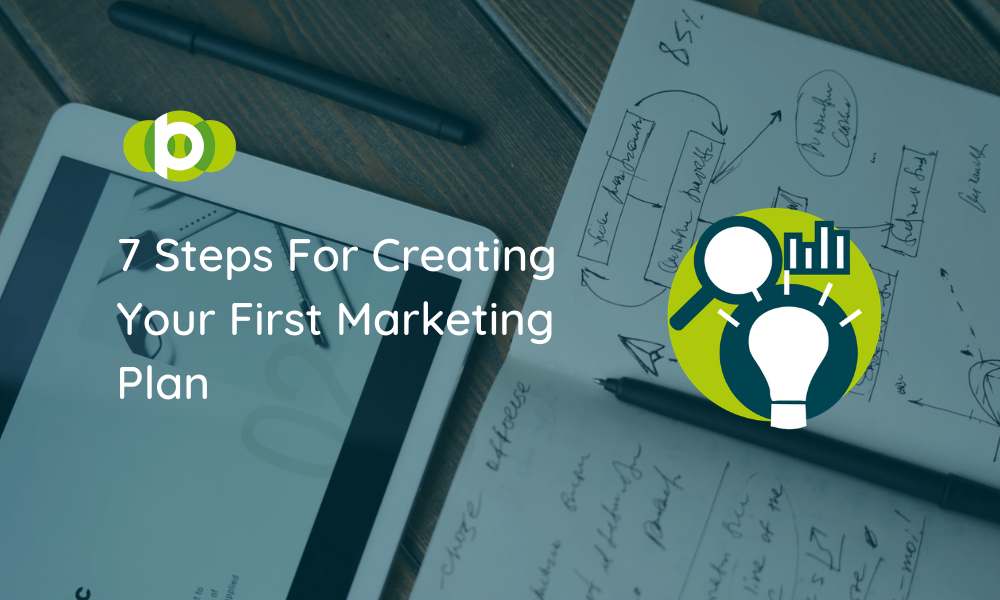There is nothing scarier than a blank page. Except, maybe a blank page that you need to turn into a marketing plan.
Knowing where to start can be pretty daunting. There are so many moving parts that you need to pull together when creating your first marketing plan. You’ve got to analyse competitors, figure out where you sit versus them, look at your team’s capabilities and figure out what your company can deliver. Then on top of that, figure out how to make money.
If all of that seems like a lot, it’s because it is.
But don’t fear. We’ve put together 7 simple steps that will help you to pull together a beginners marketing plan.
Why Create a Marketing Plan?
A Marketing plan is all about giving a business direction. Without one a business can lose focus, lose money and fail.
With a marketing plan, a company has a chance or at least a starting base from which they can blow the competition out of the water. Or at least make a decent profit.
7 Simple Steps For Creating A Marketing Plan
1. Start With Your Mission Statement
A mission statement is the foundation from which your plan is built.
Everything you do as a business should be guided by your mission statement.
It steers your company’s goals and gives clarity on everything from culture to the direction the business is going to employees.
A mission statement is so important that Forbes said, ‘high-performance organisations are linked to being mission-driven companies’ (Craig 2018). And if Forbes says it is that important then who are we to argue.
How To Create A Mission Statement
So how do you write your mission statement? The starting point is bringing different people together to talk it over in one room.
You want to bring together different company stakeholders and ask the following questions:
- What does your company do?
- How does your company do it?
- Who does your company do this for?
- What value does your company have?
As you discuss these points in depth, some common themes will start to emerge. You need to capture these. From these you can start to draft your mission statement.
Then once you finished your draft, it’s about trying to refine it. Get it down to a core message that’s between 2-4 sentences.
Mission Statement Examples:
Below are some examples of Brands who have nailed their mission statement.
Google: “To organize the world’s information and make it universally accessible and useful”
Take a look at the Google’s mission statement and apply it to some of the questions we highlighted above:
What does your company do – “Organize the world’s information”
What does your company do this for – “Make it universally accessible”
Microsoft: Our mission is to empower every person and every organization on the planet to achieve more.
Take a look at the Microsoft’s mission statement and apply it to some of the questions we highlighted above:
What does your company do – “empower every person and every organization”
What does your company do this for – To help people “achieve more”
2. Analyse The Market With A S-W-O-T Analysis
A SWOT analysis is a strategic planning technique used to identify your company’s internal and external strengths, weaknesses, opportunities & threats.
Below is a rough framework for what your company should be asking:
← Internal →
STRENGTHS
| WEAKNESSES
|
OPPORTUNITIES
| THREATS
|
← External →
Here is a real life example of a language school:
← Internal →
STRENGTHS
| WEAKNESSES
|
OPPORTUNITIES
| THREATS
|
← External →
3. Understand Your Customers With Market Research
Market research is crucial for you to really understand the perspective of your ideal customer and to gauge the influence of competitors in the market. This can be carried out through:
- Interviews
- Surveys
- Questionnaires
- Focus groups.
This market research will also help you to understand customer behaviours such as;
- How much they are willing to pay for a particular product/ service
- How often they would buy this particular product/ service.
This will undoubtedly give you a clearer understanding of the lifetime value of your clients which will drive your marketing budget.
4. Start Developing Your Modern Marketing Mix
The marketing mix is a tool used by marketers & businesses that help you identify the key aspects of your business. When this marketing tool was Initially designed, there were only 4P’s: Product, Promotion, Place & Price, but as time passed many more important P’s have been added.
Go through each one of the P’s below and answer each of the questions, as you do this exercise it will allow you to assess each point individually and collectively & help you identify any potential conflicts. Think about each point carefully and remember, decisions taken now will have an effect later on.
| Product/ Service | People | Price |
| What is your product or service? | Who are you targeting? | What is the cost of your product/ service? |
| Place | Promotion | Physical Environment |
| Where will this be sold? | How will your product/ service be promoted? | Where are your products sold in a physical environment? |
| Packaging | Processes | Planet |
| What packaging does your product need? | How will your product/ service be delivered to your clients? | How is your company caring about the environment? |
5. Set SMART Business Goals For The Short, Medium And Long Term
Define your short, medium & long term goals for your business by setting clear objectives for the quarter, the year and three years from now. When thinking of these goals, make sure you define quantifiable goals; it is essential that you are able to measure your success and have a clear understanding of what success looks like.
Also take some time to think about the much longer-term plan, how do you envisage your ideal business in the future and how you are breaking down your goals to achieve this.
When defining these goals ask yourself:
1. Are you using SMART goals?
S – Specific: Set a real target, with real numbers. Don’t be vague.
M – Measurable: How will your goals be tracked & measured?
A – Attainable: Make sure you are able to reach this goal and its not too idealistic
R – Realistic: Can you achieve this goal within your set time frame?
T – Time-based: When do you want to achieve this goal by?
2.Are all your objectives aligned?
3. Is everyone clear on the first step assigned to them?
With this in mind, move forward to define your marketing budget.
6. Calculate Your Marketing Budget
It is imperative to understand that marketing is an investment and not a cost. Never base your marketing budget on what is left over after covering all your expenses.
If done correctly, what you invest, you will gain back several times over and the advantage of digital advertising is that you will be able to clearly measure your ROI.
How to calculate your Marketing Budget?
According to Forbes, ‘it’s common for small businesses with revenues less than $5 million to allocate 7-8% of their revenues to marketing’ (Evans 2017).
However, your marketing budget will depend greatly on your business goals. For example, a company that is trying to grow their business will have a very different budget to one simply trying to maintain brand awareness.
A great way to help you define your budget is to work out your customers lifetime value (CLV), in other words the customers net profit contribution to your company over time. If you understand what that client is worth to you, it will help you to understand how much you are willing to spend to get that client.
Here’s an example of how to work out your Customers Lifetime Value.
Let’s say you sell cruise holidays, every time your customer’s take a cruise you make £500 profit, then you assume that your average customer takes 2 cruises in their lifetime with your company. Therefore your customers lifetime value is £1000.
| Profit p/sale | No. of sales in customers lifetime | Customer Lifetime Value (CLV) | ||
| £600 | X | 2 | = | £1200 |
Therefore you know that if you spend £600 to acquire 1 customer you are breaking even. As a broad guide, you want to set your target cost per acquisition (CPA) at a third of your CLV.
Target CPA = £1200 / 3 = £400
The aim is to use this as a benchmark and then continue to try to decrease your cost per acquisition over time.
7. Start Drafting The Marketing Plan
Having carried out the previous steps, you will now have a clearer idea of your target audience, how much budget you have to spend and the goals you aim to achieve over time.
Now you must define which marketing channels to use. The channel can be anything from television advertising to Google Ads. As mentioned earlier, the use of digital marketing channels are highly recommended as they will allow you to clearly measure your Return On Investment (ROI).
Below are some digital marketing channels to consider:
1. Google Ads holds 85% of the search engine market in the UK (Statista 2020)
2. Microsoft Ads hold over 10% of the search engine market in the UK, they acquired LinkedIn in 2016 which allows them to generate high quality leads (Statista 2020)
3. Facebook & Instagram Ads have seen excellent results and are a very good option if you are just starting out and don’t have a website or an adequate landing page.
4. LinkedIn offers advertising to a very specific audience, you have the option of targeting a particular industry, company, job title and many other demographic criteria.
You may not want to limit your business to advertising through just one channel, you may want to spread your eggs to reduce risk and reap the best possible results.
Once you’ve established these channels, remember to set SMART goals for each of your products/services you offer. This will become clear as you fill out Broadplace’s ‘Beginners Marketing Plan Template’ below.
Download Broadplace’s Beginners Marketing Plan Template
The following template allows you to create a plan for each of your products/services. If you’re a business that has multiple products, with different target markets and profitability, you can create multiple marketing plans.

